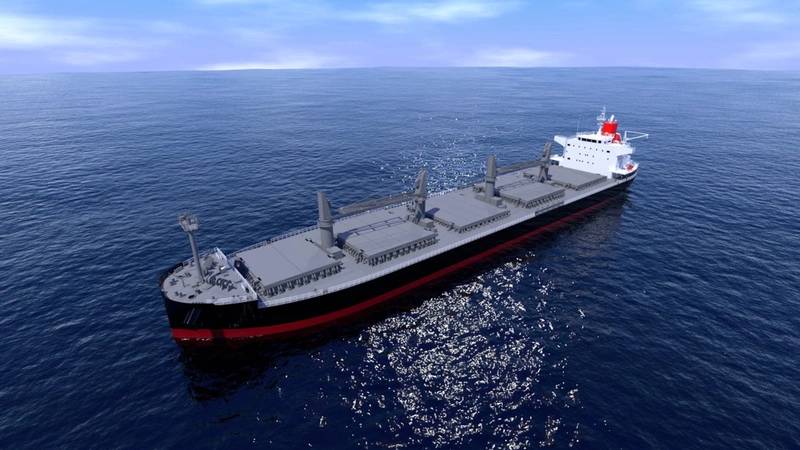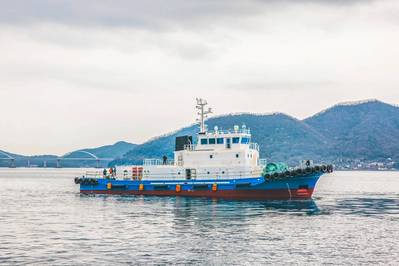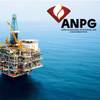Shipyard in Focus: Tsuneishi Shipbuilding – 120 Years of Innovation & Expansion
For more than 120 years, Tsuneishi Shipbuilding has been a force in global shipbuilding, evolving from a small domestic enterprise into an internationally respected brand. Established in 1903 by Katsutaro Kambara, Tsuneishi's journey mirrors the broader industrial and economic transformations of Japan and the maritime world itself.
Kambara's initial venture, Kambara Kisen Co., Ltd., was focused on shipping operations. By 1917, the company established its own construction and repair facility, Shiohama Dockyard, at the site of today's Tsuneishi Factory. In 1942, the facility was rebranded as Tsuneishi Shipbuilding, turning its focus to the construction and repair of wooden vessels critical to domestic transport during the war. Post-war, the company shifted toward steel ship construction, launching its first steel vessel, Mikomaru, in 1958. The completion of a 200,000-metric-ton repair facility in 1968 marked Tsuneishi’s arrival among Japan’s serious industrial shipbuilders.
Tsuneishi began making its mark with standardized carrier designs, starting with the TESS40 series in 1984, followed by continuous refinements with the TESS45, TESS52, and later the successful TESS58 Handymax bulkers. The Kamsarmax bulker, first completed in 2005, would become another signature product.
In the early 1990s, Tsuneishi set a template for overseas expansion that many shipbuilders would later follow. It established TSUNEISHI HEAVY INDUSTRIES (CEBU), Inc. in the Philippines in 1994, now a key part of its global production network. The launch of the first vessel there in 1997—a 23,000-ton carrier—cemented Tsuneishi's ability to deliver Japanese quality from overseas facilities. Parallel developments included growth into China with Tsuneishi Group (Zhoushan) and offshore manufacturing of hulls and outfitting components.
Milestones
Through its history, Tsuneishi has embraced technological innovation. It was among the first in Japan to develop a twin-skeg shuttle tanker (1998), secured ISO9001 and ISO14001 certifications, and invested heavily in research, establishing partnerships with institutions like Hiroshima University. Strategic moves included mergers and partnerships, such as the 2000 merger with Hashihama Shipbuilding and a notable business alliance with Samsung Heavy Industries in 2004. More recently, Tsuneishi deepened its collaboration with Mitsui E&S Shipbuilding, culminating in a 2022 acquisition that expanded its capabilities in commercial shipbuilding.
While continuing to lead in bulk carriers—celebrating major milestones like the 300th Kamsarmax and 500th TESS-series ship—Tsuneishi has diversified into new markets, including container carriers, chemical tankers, and even luxury projects like the cruise ship guntû in 2017. The company's venture into floating offshore solutions and investment in cutting-edge hydrodynamics through the acquisition of Akishima Laboratories in 2024 reflects a commitment to staying at the forefront of the maritime industry’s future.
 ‘Bingo42’ is namesake of an innovative new 42,000 dwt bulk carrier that will be jointly developed and marketed by Onomichi Dockyard and Tsuneishi Shipbuilding. Image courtesy Tsuneishi Shipbuilding/Onomichi Dockyard
‘Bingo42’ is namesake of an innovative new 42,000 dwt bulk carrier that will be jointly developed and marketed by Onomichi Dockyard and Tsuneishi Shipbuilding. Image courtesy Tsuneishi Shipbuilding/Onomichi Dockyard
Recent Developments & Deliveries
‘Bingo42’ is namesake of an innovative new 42,000 dwt bulk carrier that will be jointly developed and marketed by Onomichi Dockyard and Tsuneishi Shipbuilding. The name Bingo 42 is derived from ‘Beyond Innovation, Navigating Green Ocean’, and it was driven by the recognition of a shared challenge concerning the design workload for new vessels. In Japan, shipyards typically undertake all stages of design, from basic design to production, on an individual company basis. This approach necessitates a substantial design workload when a new design is developed, placing a significant burden on the design team. This is further expected to increase in the future, particularly in response to alternative fuel vessels, and with their close geographic proximity, Onomichi and Tsuneishi mutually decided that cooperation made sense.
Bingo42 is modification of the handy size bulk carriers in both companies’ existing product ranges, and in the development project the shipyards are working to leverage previous experience to improve the vessel design. This includes discussions on how to enhance each other’s conventional hull forms. The length of the conventional hull form has been increased by 3m, and the hull form has been optimized, improved cargo capacity and fuel efficiency for Onomichi’s 40BC and resulting in improved fuel efficiency for Tsuneishi’s TESS42. In addition, MT-FAST has been installed as an energy-saving measure, resulting in improved propulsion performance and fuel efficiency compared to both companies’ conventional hull forms. The design has achieved a reduction of more than 35% from the reference line, and is also designed to be methanol dual-fueled.
 Tsuneishi launched Japan’s first hydrogen dual-fuelled tugboat.
Tsuneishi launched Japan’s first hydrogen dual-fuelled tugboat.
Image courtesy Tsuneishi Shipbuilding- Hydrogen Fuel Tugboat Main Particulars
LOA: 38m
Breadth: 9.6m
Draft: 4.2m
Gross Tonnage: less than 300
Main Engine: Twin 4,400-hp, 12-cylinder hydrogen dual-fueled ICE
Another Tsuneishi Shipbuilding milestone was the launch of Japan’s first tugboat to be equipped with a hydrogen-powered internal combustion engine (ICE). This vessel – which also used “JGreeX” which are produced by JFE Steel Corporation as green steel for all of its steel plates – was launched on March 28, 2025, and is equipped with a high-power output hydrogen dual-fueled ICE and a high-pressure hydrogen gas storage system with large-capacity and supply.
This vessel was developed and built as part of the The Nippon Foundation’s “Zero Emission Ships Project”, which aims to develop vessels with zero CO₂ emissions.
This tugboat is installed with twin 4,400-hp, 12-cylinder hydrogen-blended engines, and by hydrogen in combination with traditional marine fuels, with the target of reducing carbon dioxide emissions by approximately 60%. With facilities to store approximately 250kg of high-pressure hydrogen gas, it is possible to maintain the same operational performance as when using conventional fuel. In the unlikely event of failure of the hydrogen fuel system, the vessel can operate with traditional marine fuels. A methanol-fueled container vessel takes shape in Tsuneishi’s Chinese Shipyard.
A methanol-fueled container vessel takes shape in Tsuneishi’s Chinese Shipyard.
Image courtesy Tsuneishi Shipbuilding
Tsuneishi Group (Zhoushan) Shipbuilding Inc. – its shipbuilding factory in China – recently completed the first block loading for its first Methanol-Fueled 5,900-TEU Type Container Carrier.
The 5,900-EU type container carrier is the largest container carrier built by Tsuneishi Shipbuidling Group, with a maximum capacity of 5,915 TEU in the hold and on deck, and up to 1,400 reefer containers. In addition to the enhanced hull form and MT-FAST, its energy-saving technology, the integration of a large-capacity shaft generator has enabled this dual-fuel vessel to achieve both optimal loading performance and exceptional fuel economy when compared with fuel oil vessels in the same segment. This vessel has been developed based on the concept of a final solution for the zero CO₂ emission vessel through the use of green methanol. Not only the main engine but also all on-board generators, HiMSEN engine (8H32DF-LM) which will be supplied by HD Hyundai, can be methanol-fueled. Tsuneishi Heavy Industries (CEBU), Tsuneishi’s factory in the Philippines, takes on a new challenge with the world’s first methanol-fueled KAMSARMAX.
Tsuneishi Heavy Industries (CEBU), Tsuneishi’s factory in the Philippines, takes on a new challenge with the world’s first methanol-fueled KAMSARMAX.
Image courtesy Tsuneishi ShipbuildingMeanwhile, Tsuneishi Heavy Industries (CEBU), Tsuneishi’s factory in the Philippines, completed the first block loading for its first Methanol Dual-Fueled KAMSARMAX Bulk Carrier in late April at THI Slipway No.2. The vessel is scheduled to be launched in July 2025 and delivered in January 2026. This methanol-fueled vessel is a new type that combines environmental performance with economy. To make the newbuild possible, the yard made new capital investments and sent personnel to Tsuneishi Shipbuilding for R&D and training, and it is actively working to acquire the technology for the production of methanol fuel tanks and their components. With an overall length of 229m and a cargo capacity of 98,000 cu. m., it offers excellent flexibility for transporting the three major bulk commodities of iron ore, grain and coal.











